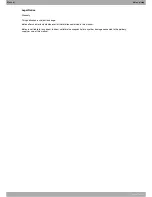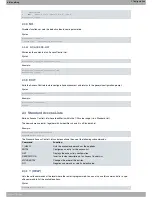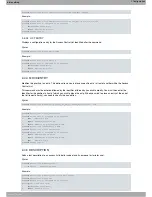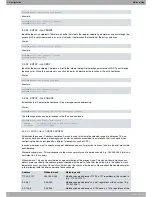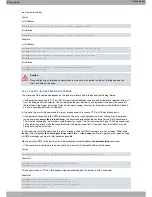
that allow you to configure the router, enter the feature command followed by a question mark (?).
Example:
Config>feature ?
access-lists
Access generic access lists configuration
environment
bandwidth-reservation
Bandwidth-Reservation configuration environment
control-access
Control-access configuration environment
dns
DNS configuration environment
frame-relay-switch
Frame Relay Switch configuration environment
ip-discovery
TIDP configuration environment
ldap
LDAP configuration environment
mac-filtering
Mac-filtering configuration environment
nsla
Network Service Level Advisor configuration
nsm
Network Service Monitor configuration environment
ntp
NTP configuration environment
prefix-lists
Access generic prefix lists configuration
environment
radius
RADIUS protocol configuration environment
route-map
Route-map configuration environment
scada-forwarder
SCADA Forwarder configuration environment
sniffer
Sniffer configuration environment
stun
Stun facility configuration environment
syslog
Syslog configuration environment
tms
TMS configuration environment
vlan
IEEE 802.1Q switch configuration environment
vrf
VRF configuration environment
wrr-backup-wan
WRR configuration environment
wrs-backup-wan
WRS configuration environment
Config>
To access the Access Controls configuration menu, enter, from the configuration root menu (PROCESS 4), the word
feature, followed by access-lists.
Example:
Config>feature access-lists
-- Access Lists user configuration --
Access Lists config>
You will then access the main Access Controls functionality configuration menu. Here you can create, eliminate and
view the access lists.
Each Access Control List is made up of entries, where you can indicate criteria and the parameters that grant or
deny access.
There are three types of Access Control Lists: Standard, Extended and Stateful.
Very few parameters are used in the Standard lists to define the characteristics of each Access Control entry. Exten-
ded lists, however, allow you to define a larger number of selection parameters.
With Stateful lists, users can also specify the connection status (established, new, etc.) and type of connection (rtp,
peer to peer, etc.).
There are three submenus within the main Access Lists menu, one for each type of list. Each submenu is accessed
when editing a specific list, depending on whether the type selected is Extended, Standard, or Stateful.
2.3 Main Configuration Menu
Creates and deletes lists from the main Access Control configuration menu. You can also view the configuration of
the lists that have been created.
An access list is made up of a series of entries. Each entry in the list is a block of sentences and an
action
, and is
identified by a unique number (the entry identifier or ID field). The sentence block is made up of a source IP address
(or range of addresses), a destination IP address (or range of destination IP addresses), a protocol (or range of pro-
tocols), source and destination ports (or range of ports) and the connection identifier for all interfaces the packet
goes through. The
action
sets forth the criteria that must be applied to the IP packets meeting the requirements
defined by the sentences. The action can be one of two types:
permit
or
deny.
2 Configuration
bintec elmeg
4
Access Control


